It's that time of year again. Time to dust off the decorations and post the Fudebakudo Christmas animation.
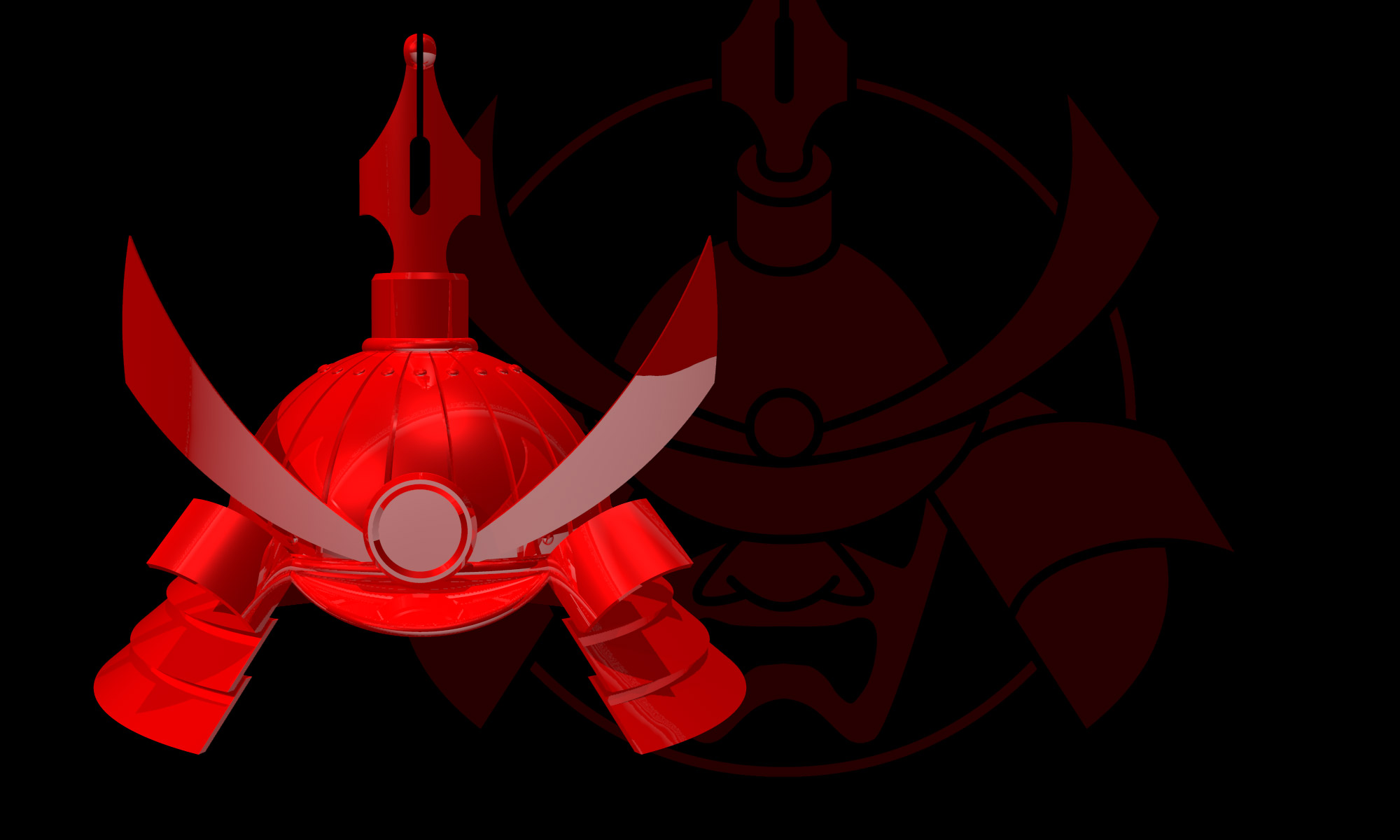
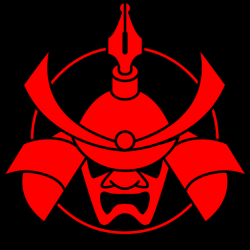
But a sword dipped in ink, now, that's a good compromise
It's that time of year again. Time to dust off the decorations and post the Fudebakudo Christmas animation.
Last week I went to the O2 to see the Albarn/Hewlett production of Monkey Journey to the West. My interest in such a thing—apart from a nostalgic fondness for the cheesey Monkey TV series—was fuelled mainly by an appreciation of Jamie Hewlett's wonderful artwork. The show really did manage to extend the illustrations onto the stage, and, to be fair to the sometimes rather annoying Mr Albarn, the music worked well too. It helped that I had hooked up with a long-unmet friend for the event, but even without that bonus I realised, when the interval came, that I'd had a big monkey grin on my face for the whole first half. It's a show not to be taken seriously, and it really was a lot of fun.
My favourite part was probably Princess Iron Fan, because she had a lieutenant who was incredible foxy with the best costume and great spiky hair. But I liked the way Tripitaka (played by Yao Ningning) walked the way you knew Hewlett would have animated him (her). Cao Jiangtao in the eponymous role of Sun Wu Kong (that's Monkey to you) was tremendous too, maintaining his monkey swagger and monkey bravado throughout.
Mind you, the special Chinese meal, available in the "Monkey's World" restaurant as part of the experience in the big black tent, was woeful. In fact it would have been laughable had it not been so expensive. London has great Chinese restaurants, both pricey and cheap, so it's frustrating to have given them a miss for something that was badly cooked and inaccurately served. Missed my lap; but the guy on the next table wasn't so lucky.
An intriguing aspect of the project is that the official MJTTW website is plainly based on the Fudebakudo website. This website is itself based on Fudebakudo's esoteric design principles, of course: see the FAQ on Why is everything black, white, and red? if you don't believe me.
Unfortunately the official trailer for the Monkey show is cut together so wildly you really can't make much out, so I haven't bothered linking to it. It's an odd thing to do in a publicity video because it makes you think they're deliberately hiding something by taking it away before you can see it properly. Instead, the short film Monkey Bee gives a good flavour of the music and the playfulness of the project (you also get to see some of the cast — although the film has been done in a wonderfully vintage cinematic style instead of simply using the scenes, make-up, and costumes of the stage production). What's more, thanks to the helpful subtitles, you can sing-along (in Mandarin) in Youtube karaoke!
Sad:
Monks brawl at Jerusalem shrine
You can see from this why David Carradine played Kwai Chang Caine as a Shaolin monk. In the original screenplay he was going to be Greek Orthodox, but the fight scenes looked way too scrappy when they played them out in slow motion.
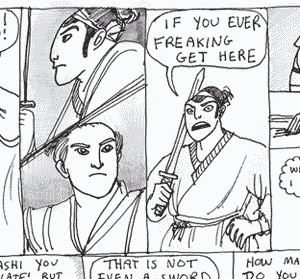
Kate Beaton's version of a famous Musashi incident — see the full cartoon
Mushashi Miyamoto — Japan's legendary yet real swordsman . . . if you don't know anything about him, the rest of this won't make much sense (but then, there's always the Wikipedia page. Oh all right then: maybe this one).
So, anyway . . . Canadian web comic artist Kate Beaton has retold one of Musashi's most famous encounters: see this fabulous Musashi cartoon.
There are several Musashi references in the Fudebakudo book. I deliberately included two conflicting versions of how he founded the niten-ryu because, since nobody ever checks their facts, I thought I might as well make Fudebakudo inconsistent. After all, that's how all good myths perpetuate.
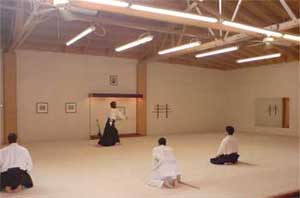
The Portland Aikikai dojo is itself so aesthetically pleasing it's a wonder they let ugly visitors on the mat at all.
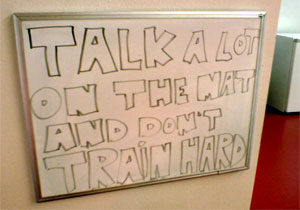
The sign said "SHUT UP AND TRAIN" when I first turned up. A week later, it had been changed. Not by me.
It's been quiet on the Fudebakublog because I've been busy — just back from Portland, Oregon, working on the current Beholder project. I must thank my excellent and long-suffering hosts, Judith and Eric of Foreworks, for putting up with me. The Chinese say, "After three days, guests and fish begin to stink," so those two were very tolerant; I was there ten days. It was a productive time, working on material that should be out in 2009.
It was also super-cool to meet up in Real Life with a long-time (no, really: well over a decade) online friend Robert, and his lovely wife and duty adult Elaine (it quickly became clear, I think, that Robert and I had a tendency towards childishness — in a good way, obviously). Oh, and talking of American critters, the raccoons and possums I had been promised failed to show up. Actually, I did see one raccoon, and that was on the way in from the airport, and it was lying peacefully by the side of the road, having tarmacadam dreams. But I don't think that counts.
While I was over there, I managed to catch a couple of classes at Portland Aikikai. I took these two unapproved photos as I snuck out the door, which was a bit rude since everyone had been very friendly. And I do mean friendly, even though, when I had first arrived, I could not help but overhear "casual" talk in the changing rooms about the Iron Man triathlon in what I now suspect was a subtle yet deliberate attempt at psychological intimidation. Heh, a nice trick, gentlemen.
The rise in popularity of Mixed Martial Arts (MMA) seems to have been at the expense of traditional martial arts. From the perspective of being the publisher of Fudebakudo, that's a move in the wrong direction (it's primarily why we didn't have a stand at Seni this year) because Fudebakudo is based on a very traditional model. But since popularity is massively influenced by the media, and especially broadcast media, it's fascinating and wholly correct to see MMA take over as the most popular form of martial art. It's interesting because, the way I see it, its ascendency is based largely on two things: how effective it appears to be, and how violent it is.
The reason it's especially interesting to me is because it seems that these two aspects are exactly opposed in the most traditional martial arts. Or, to put it another way, the traditional approach is almost perfectly unpopular as far as modern audiences are concerned. Of course comparing traditional MA like karate or judo with MMA as exhibited in cage fights is a little like comparing apples and oranges. Yes, they set out with different goals — one is largely about self-improvement (oh, it's spiritual, don't you know?) and the other is about winning fights. But still, even though there are crossovers and exceptions, I think it's valid to draw conclusions by considering the mainstream of each approach.
So here it is: the traditional martial arts are usually in denial about full-on tests of efficiency, and are dogmatically in denial about violence. The repetitive nature of kata (repeated patterns), the formalised approach to sparring, and the fairly rigid boundaries of syllabuses mean that it's easy for someone to practice and become proficient without ever really knowing if they can actually do any of what they have learnt outside of a training environment. (Yes of course there are exceptions — the Kyokushinkai people put themselves to the test in open tournaments (uh, standing up, mind you) — but that's why they have a reputation that sets them apart from the less rugged karate styles). And the traditional martial arts are explicit about their denial of violence: the focus is on control and technique. Mainstream aikido, for example, is wholly allergic to admitting to any violence, focussing instead on its non-aggressive ideal, but even percussive arts usually stress that it's all about correct form, clean technique, and discipline. None of the books by the karate masters will say that the prospect of giving (or watching) a good thrashing is a genuine reason for getting involved in the art.
But the MMA have no such outward qualms, which means they simply have a better, more viscerial appeal. Yes, there are rules and split decisions, but, by the end of fight, you can usually tell, even as an inexperienced viewer, who is the winner. And, oh yes, the violence of the spectacle is absolutely acknowledged in its appeal. With a little reflection you realise that the cage isn't really a requirement of the art but that it serves to keep the non-stop, non-cornered action in front of the camera, all of the time.
This is an outward thing. Inwardly, the traditional MA practitioners may in fact be getting secret, naughty thrills from the violence even though they are not supposed to be. Similarly, serious MMA people are surely getting broadly the same benefits of self-improvement from their rigorous and technical training as the traditionalists do. There's no thrill of violence in early morning sessions in the gym seven days a week, for example. That's all about self-discipline, pure and simple.
But outwardly . . . well, this is why the MMA will be more popular. From a public point of view, coupled with an instant broadcast media, the MMA are so much more honestly pitched: easy to understand violent action. Compared with, say, the slightly bemusing spectacle of the Beijing taekwondo judging, it's fairly obvious who's got the media angle right. Judo and sumo only become compelling spectator sports when, like opera or pigeon fancying, you've taken the trouble to learn to appreciate the technicalities. There is, after all, a reason why Sky Sports haven't been clamouring for the broadcast rights to the International Aikido Federation's congress in Tanabe this year.
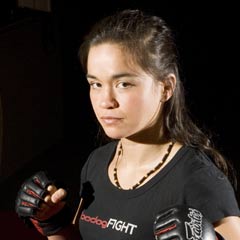
Rosi Sexton: "With a bit of hand waving it could be argued that the construction P A on a frame A is the point-free analogue of the point-sensitive construction PS on a space S. However, as we will see, this is not entirely correct."
PhD thesis, p.5
I want to clarify that this is about popularity, it's not a judgement on the value of the arts, if MMA are right or wrong, or even what works "on the street" (or, as we prefer to say in Fudebakudo, "on the boulevards" — it's a class thing). Also the reasons people train in any combat art, and the benefits sought from doing so, will vary from person to person. But what gets people into the clubs in the first place is largely down to its outward appeal via the media. Bruce Lee did it for kung fu (and, by confused implication, for all the traditional martial arts) in the 1970s, with the theatre of cinema. The MMA are simply doing it today with the uncomplicated, gutsy appeal of reality TV.
I've meant to write about this for some time, and was finally motivated to do so by this recent Guardian article on Rosi Sexton. I encourage Fudebakudo readers to read her thinking-out-loud blog. And, top kudos to the number one female British MMA fighter for also linking to her Maths/CompSci thesis on point-set topology. That is just so cool.
Oh, and if you don't like the violent aspect, don't watch the video of her last fight with Windy Tomomi. You don't have to be an osteopath to know ankles shouldn't do that. Ugh. There's a related article in MMA News, which contains Sexton's reaction to the event.
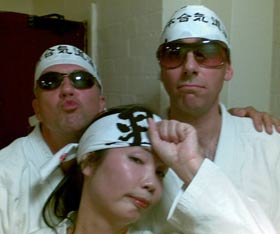
Disturbingly cool. Or, at the very least, disturbing.
I've been away for a while, including spending several days at an aikido "summer school." I am protecting the anonymity of Roy and the others in this photograph by not mentioning any names. You might be reassured to know that this is not how people normally dress for aikido, but is in fact a troupe of highly trained artistes having come offstage (well, out of the bar) after delivering the world premiere of Madonna's aikido version of Vogue. With the words changed, obviously.*
I can't help noticing that the girl looks uncannily like the one in the how to fold a hakama movie.
* There were five of us them in the group (known collectively as Quality of the Dojo) but I've only come back with a photo of three. So if you were there and took a photo of the whole bunch, please let me know, so I can put that up too. I don't want Penny and Louise, who will also remain anonymous, to feel left out, obviously.
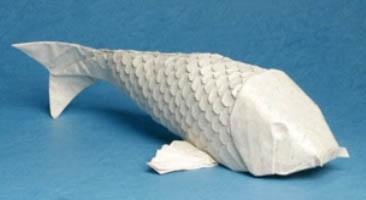
Fish + paper, Japanese style.
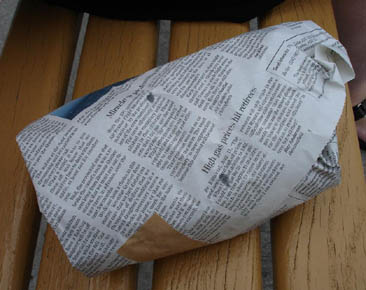
Fish + paper, western style
(actually this one is from Don's Fish & Chips in Brockville, ON).
It's a matter of record that Fudebakudo was responsible for revealing the forgotten martial origins of origami. Fudebakudo even gave the world downloadable slippers by combining the awesome twin-technologies of origami and internet.
But there are other people pushing back the folded envelope. Robert Lang's recent TED talk shows some state of the art origami that frankly makes the slippers look a bit clunky — the fish shown here is an example.
I particularly like his observation that, "The secret to productivity in so many fields is [. . .] letting dead people do your work for you".
If Lang's approach is all a bit too academic and impractical, just learn to fold paper the way the instant origami masters do it.
Like most cartoonists, when I was a child I was fascinated by cartoons. Specifically, I liked to see how they were drawn — for example, although I enjoyed Asterix books because they were funny, I also scrutinized the hands because they were so well drawn. Sometimes I'd look though a book just to compare all the hands, say, or the horses. Or the consistent way the buildings were drawn.
So Dinosaur Comics is something of an enigma: I read it more or less every day — and laugh out loud at T-Rex and his friends. Part of the amusement is that the drawings never change. Every day different words, but the same pictures. People who aren't into Dinosaur Comics (I was such a person, once) don't get how that works, how that can possibly work. Of course, the reason it does is because the characters' ideas are so smart and funny. But still, there's something disturbing, and amusing, about the implication that a cartoon doesn't need its pictures as much as most cartoonists think it should. Heh. Thanks T-Rex for pointing that out, every time.
Ryan North, the guy who does (I can't easily say "draws" there) Dinosaur Comics gave an interview last week. This quote is a little out of context, but he said:
"…if there were three otherwise-identical people in a room, one holding a big placard that read "CARTOONIST" while the other two had "ENTREPRENEUR" and "WRITER" signs, I'd really want to talk to the cartoonist."
Heh! Me too! That reminded me of the fabulous Kliban cartoon below. I had this cartoon on my door for many years, cut out from Kliban's obituary in a British broadsheet — "Out of the way, you swine! A cartoonist is coming!"
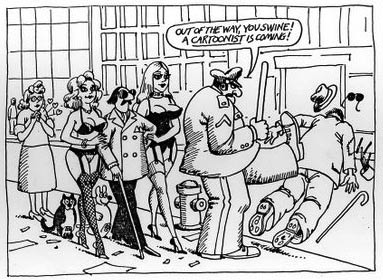
Cartoon by the late, great B. Kliban.
Sometimes martial artists can become so absorbed in their pursuit of . . . of . . . of whatever it is that they are pursuing, that they get lost in a vortex of idiocy. For example, somewhere along the line person B was convinced by person A that this was a good idea: Fruit slice.
Fruit abuse: Fudebakudo drew the public's attention to fruit abuse in the martial arts way back at Seni 2007. But still it goes on. Who is supplying these people? Are there backstreet fruitiers and shady greengrocers who simply don't care what happens to the vegetables they are trafficking? This madness has to stop.